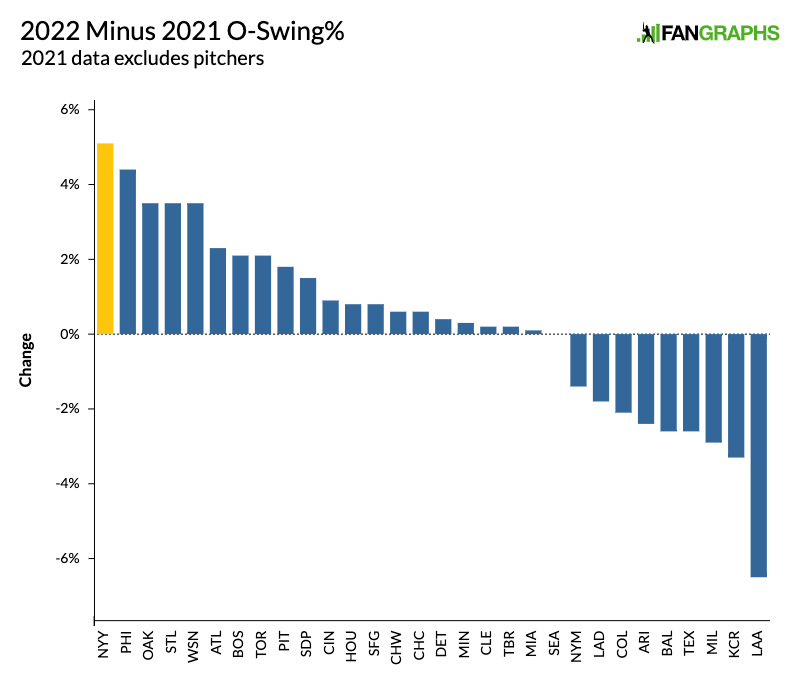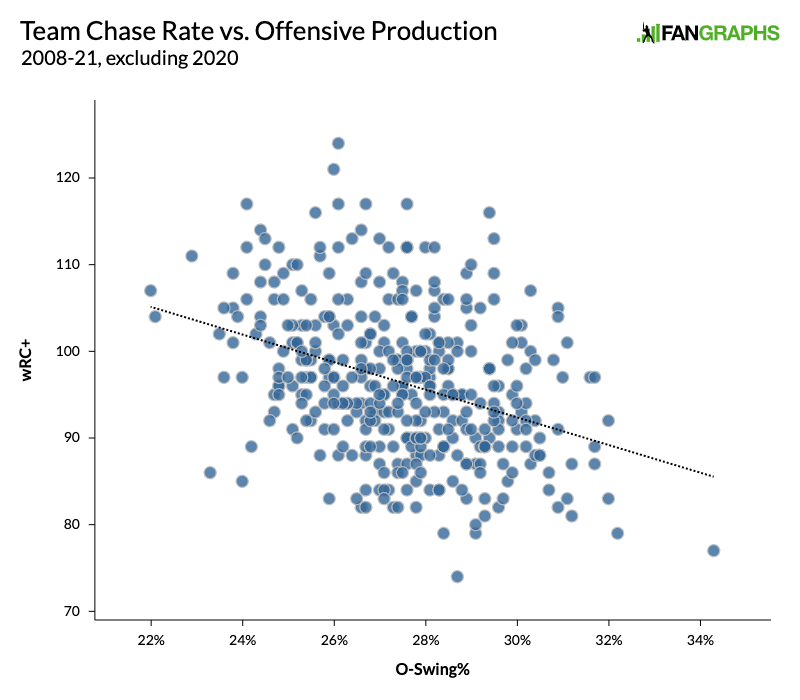The Yankees Are Good Despite Their Plate Discipline (Or Lack Thereof)

I have some good news about the Yankees. Their collective 120 wRC+ is tied for first among all teams in baseball, an achievement that seems like an amalgamation of skill rather than luck. Case in point: They’re leading the league in every conceivable Statcast metric, including average exit velocity, hard-hit rate, and barrel rate. By hitting baseballs at blistering speeds, the Yankees are turning them into valuable extra-base hits. It’s an ideal process, especially in a season where said hits have been harder to come by.
Next, I have some not-as-good news about the Yankees. It’s something I noticed while looking into Joey Gallo. The lefty slugger recently recorded his first two homers of the season, but his overall batting line is still under water. He’s striking out over 40% of the time, and the little contact he does make hasn’t returned much. You might think this is because Gallo goes after pitches he shouldn’t à la Javier Báez, but last season, he ran one of the best out-of-zone swing rates around. The problem is that even when he’s offered an attractive pitch, he has a gruesome tendency to whiff at it. When Gallo slumps, he doesn’t do so in a manner that’s even the slightest bit flattering.
This season has been different in the worst way possible. Not only is Gallo missing hittable pitches, but he’s also chasing after ones he formerly didn’t. His chase rate has ballooned from last season’s pristine 19.2% mark to a career-worst 30.5%. He’s not the only Yankee to exhibit this backwards progression, though. I smell a graph! Below is a scatterplot containing hitters with at least 300 plate appearances in 2021 and 50 in ‘22. On the x-axis are their chase rates from last year, and on the y-axis are their chase rates from this year:

A metric like O-Swing% (i.e. chase rate) tends to be reliable year-to-year, which is why the points are bunched up to form a linear relationship. But all those disparate yellow dots? They’re all Yankees hitters, and among the eight included, five (besides Gallo, they represent Josh Donaldson, Isiah Kiner-Falefa, Giancarlo Stanton, and Gleyber Torres) are way above the displayed trend line. The other three are Aaron Judge, DJ LeMahieu, and Anthony Rizzo; that they’ve been driving the Yankees offense so far is perhaps not surprising. This plot does leave out Aaron Hicks, who didn’t have enough plate appearances in 2021 to qualify but is currently swinging at just 14.3% of pitches outside the zone. He makes his squad look better. Still, as a whole, no other team is chasing at a higher rate of balls relative to last season:

It’s a puzzling development when you consider recent history. The Yankees offense might have been worse than merely decent (101 wRC+) last season if not for a 24.6% chase rate, good for third behind only the Dodgers and Giants. That represented a continuation from 2020, when the Yankees were second in chase rate, and the year before that, when they were ninth. For a while, this has been a team that’s established an ironclad sense of discipline at the plate. Now, suddenly, the Yankees are headed in the opposite direction. They’re still in great shape, mind you, but this seemingly out-of-nowhere change is another reason baseball doesn’t always totally makes sense.
Now, a stellar lineup doesn’t necessarily need standout discipline – the current Yankees are an example of how that’s possible. But in general, even though swing decisions might not be as important as, say, bat speed, they’re nonetheless integral to a team’s offensive output. While we’re on the subject, we may as well give the relationship between the two a thorough look. First, here’s the basic correlation between team chase rate and wRC+ since 2008:

Swing-happy teams do tend to have poor offenses, but again, the relatively flat trend line demonstrates that there are plenty of exceptions to the rule. The plot doesn’t do the best job of capturing why discipline matters, though. We can easily spot the individual teams but not the overall picture, which is that the absence of discipline has a much greater impact than its presence. Before arriving at that conclusion, I started by sorting the above teams into different groups based on their O-Swing% percentile, then calculated the mean wRC+ of each group. Here’s a table with the resulting calculations. In this case, a higher percentile means that a team swung at more pitches outside the zone:
| O-Swing% Percentile | Sample | Mean wRC+ |
|---|---|---|
| <25th | 95 | 101 |
| 25th to 50th | 92 | 96.5 |
| 50th to 75th | 103 | 95.7 |
| >75th | 100 | 92.9 |
It’s up to one’s own interpretation, but the way I see it, swing decisions are sort of a low-ceiling, high-floor skill set. When chase rate is isolated, we can see that an elite mark only grants teams about a league-average offense (101 wRC+). On the flip side, we can also see that a poor mark limits teams to a sorely below-average offense (93 wRC+). Good teams may not need standout discipline, but it means they’ll be in for an uphill battle. To elaborate, the less-than-25th-percentile group does in fact contain 45 teams that are below-average offensively by wRC+. Swing decisions alone don’t move the needle that much. But when you realize the greater-than-75th-percentile group contains just 15 teams (out of 100!) that are above-average, its value becomes apparent. Refraining from swinging outside the zone won’t return the most bang for a team’s buck, but it’d be foolish not to do so.
Circling back to the Yankees, who belong in the latter group, perhaps they’re in a worse shape than previously thought. Other elements of their offensive game are making up for the fact that Gallo and company are swinging at sliders in the dirt, but how long can they last? The first 10 or so Yankees games this season showed what happens when there’s a lack of discipline without the slugging to cover it up. Moreover, the question remains of why the Yankees have abandoned their patient ways. On that matter, it’s hard to ignore the presence of a possible new philosophy. After spending three years as a minor league hitting coordinator, Dillon Lawson became New York’s primary hitting coach this offseason. I’m not sure what ideas he has in mind, and I doubt anyone but those within the organization know for certain. And for it’s worth, no coach would want his guys to go after pitches outside the zone. Is the uptick in chase rate an unintended consequence of what he’s trying to accomplish? Maybe so.
Of course, this is also a different Yankees squad compared to even last year, so it’s not as if longtime players are adding aggression en masse. A new permutation of hitters could reasonably have an overarching, synergistic influence on an entire lineup. But the fact remains that most Yankees are underperforming their baseline chase rates regardless of how many years they’ve been in pinstripes. And while chase rate alone can’t provide a comprehensive evaluation of a hitter’s swing decisions – a topic explored by Ben Clemens yesterday – how one reacts against pitches outside the zone arguably matters most. If a hitter goes after a pitch outside the zone, he needs to compensate with several swings inside the zone. It’s quite the price to pay.
There’s no reason to panic, though – we’re still in small sample territory here, even when it comes to a metric like O-Swing%. We are at roughly the point when swing-based metrics “stabilize,” but all that means is we can now weigh this year’s numbers more heavily than last year’s to project a player’s performance moving forward. Even then, what a player did before is still going to matter a lot this early in the season, and the Yankees have an extensive track record of prioritizing plate discipline and recruiting hitters who possess it. Gallo has never been this indiscriminate, and the same can be said of Donaldson and Kiner-Falefa. It’s safe to bet on their chase rates going down, despite recent at-bats suggesting otherwise.
If anything, that the Yankees are this good even with an inflated chase rate shows just how scary they are. In a lot of ways, their destruction of opposing teams reminds me of the 2019 Twins. The famed Bomba Squad ran the league’s 19th-best chase rate, but scored runs like no other thanks to a penchant for crushing baseballs. Fittingly, that lineup has the highest wRC+ (116) among the many in that greater-than-75th-percentile group. In an interview earlier this year, Lawson said his approach to hitting could be summed up as “hit strikes hard.” The Yankees are doing exactly that, albeit at the (so far) minor but potentially significant cost of indulging in bad swings. We’ll get to see how this holds up. It’s interesting to think, though, that it just might represent a new normal.
Statistics in this article are through games of May 1.
Justin is an undergraduate student at Washington University in St. Louis studying statistics and writing.

Really interesting article. I grew up in the early aughts when the Yankee philosophy was power and lots and lots of patience; very intriguing to see this data broken out thusly.